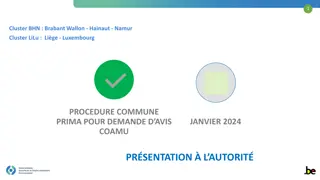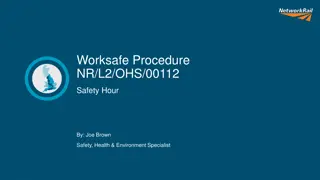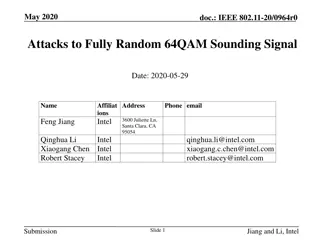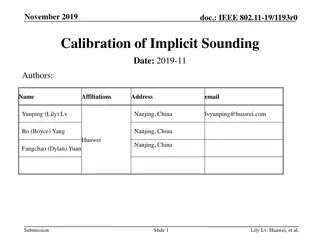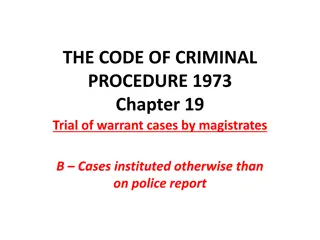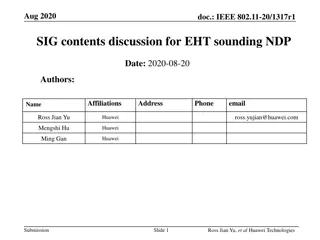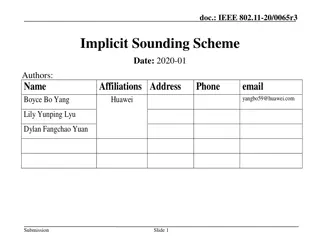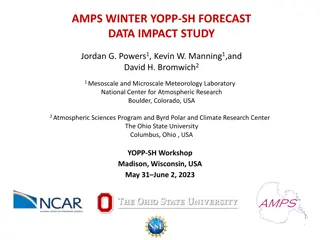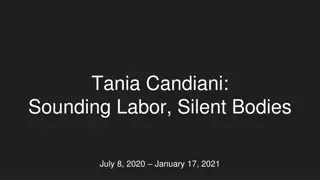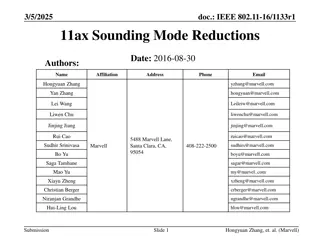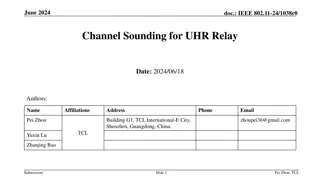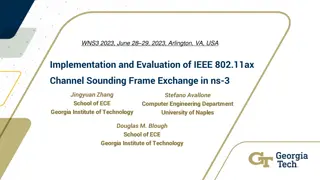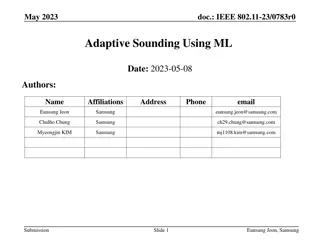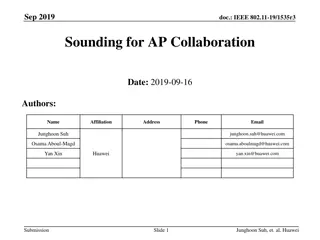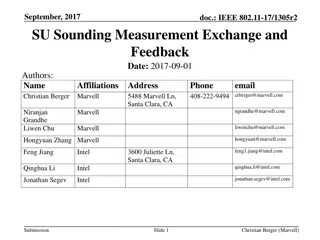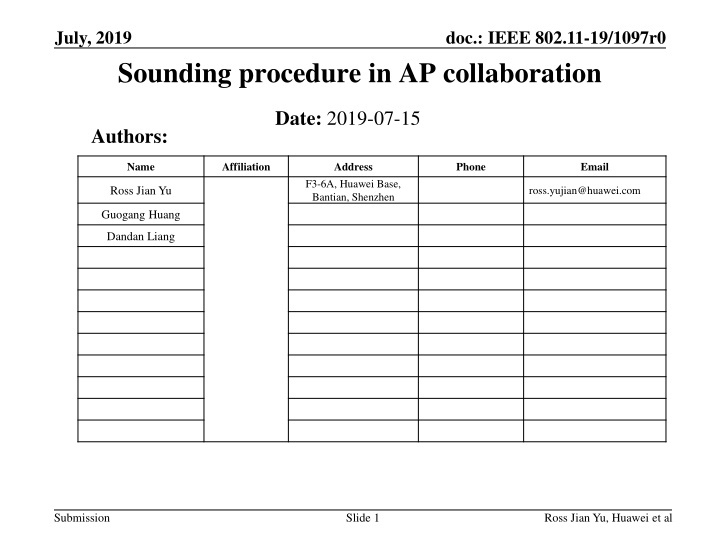
IEEE 802.11-19/1097r0 Sounding Procedure in AP Collaboration
Explore the sounding procedure in AP collaboration as discussed in the IEEE 802.11-19/1097r0 document for improved channel state information collection across BSSs. The procedure involves NDPA, NDPs, and collecting CSI to enhance communication efficiency in WLAN networks.
Download Presentation

Please find below an Image/Link to download the presentation.
The content on the website is provided AS IS for your information and personal use only. It may not be sold, licensed, or shared on other websites without obtaining consent from the author. If you encounter any issues during the download, it is possible that the publisher has removed the file from their server.
You are allowed to download the files provided on this website for personal or commercial use, subject to the condition that they are used lawfully. All files are the property of their respective owners.
The content on the website is provided AS IS for your information and personal use only. It may not be sold, licensed, or shared on other websites without obtaining consent from the author.
E N D
Presentation Transcript
July, 2019 doc.: IEEE 802.11-19/1097r0 Sounding procedure in AP collaboration Date: 2019-07-15 Authors: Name Affiliation Address Phone Email F3-6A, Huawei Base, Bantian, Shenzhen Ross Jian Yu ross.yujian@huawei.com Guogang Huang Dandan Liang Submission Slide 1 Ross Jian Yu, Huawei et al
July, 2019 doc.: IEEE 802.11-19/1097r0 Background In 11ax (and before), sounding procedure is done within a BSS. AP HE NDP Announcement HE NDP SIFS SIFS SU PPDU CSI from HE STA STA AP HE NDP Announcement BRP Trigger BRP Trigger HE NDP SIFS SIFS SIFS SIFS SIFS HE Trigger-based PPDU CSI from HE STAs HE Trigger-based PPDU CSI from HE STAs STA 1 . . . STA n Zero or more times In 11be, with AP coordination, channel state information across BSSs are needed. Hence, sounding procedures with multiple APs and multiple STAs need to be designed. Submission Slide 2 Ross Jian Yu, Huawei et al
July, 2019 doc.: IEEE 802.11-19/1097r0 Background Assume there are two BSSs, AP1 and AP 2 are two BFers. STA1 is associated with AP1, STA2 is associated with AP2. STA1 and STA2 are two BFees. AP1 also acts as the master AP. AP2 acts as the slave AP. AP1 AP2 STA1 STA2 Submission Slide 3 Ross Jian Yu, Huawei et al
July, 2019 doc.: IEEE 802.11-19/1097r0 Sounding Procedure - NDPA The master AP (AP1) will first send EHT NDPA, followed by NDP. The NDPA will indicate: The APs that are involved in the sounding procedure. The sounding parameters per each AP-STA pair. A shared AID space is preferred for STAs involved in AP coordination.. AP1 ... NDPA NDP1 trigger AP2 ... NDP2 STA1 ... STA2 ... Submission Slide 4 Ross Jian Yu, Huawei et al
July, 2019 doc.: IEEE 802.11-19/1097r0 Sounding Procedure NDPs After the first NDP sent by the master AP, the other slaves AP will send NDP sequentially following the sequence specified in the EHT NDPA . Each slave AP can also transmits its own NDPA Each slave AP can adjust CFO and timing offset based on the NDPA sent by the master AP before transmitting NDP Multiple APs may send joint NDPA frames and NDPs multiplexed in freq./spatial domain. Submission Slide 5 Ross Jian Yu, Huawei et al
July, 2019 doc.: IEEE 802.11-19/1097r0 Sounding Procedure - Collecting CSI After the NDPs, the master AP will send BFRP trigger frames to solicit beamforming report (BFR) from each STA. There are several options: Opt1: each AP collects its own CSI, i.e., AP1 collects CSI (AP1 STA1, AP1 STA2), AP2 collects CSI (AP2 STA1, AP2 STA2). Pro: for transmission like CoBF, co-OFDMA, no need to exchange CSI between APs. Con: AP needs to collect CSI from non-associated STAs. Transfer frame AP1 trigger trigger NDPA NDP1 Return frame AP2 NDP2 trigger BFR (AP1) BFR (AP1) BFR (AP2) STA1 BFR (AP1) BFR (AP2) BFR (AP1 STA2 Submission Slide 6 Ross Jian Yu, Huawei et al
July, 2019 doc.: IEEE 802.11-19/1097r0 Sounding Procedure - Collecting CSI Opt2: each AP collects CSI only from its associated STA(s), i.e., AP1 collects CSI (AP1 STA1, AP2 STA1), AP2 collects CSI (AP1 STA2, AP2, STA2). Pro: CSI is exchanged within each BSS Con: needs to exchange CSI through wired/wireless transmission Transfer frame AP1 trigger trigger NDPA NDP1 Return frame AP2 NDP2 trigger BFR (AP1&2) BFR (AP1&2) STA1 BFR (AP1&2) STA2 Submission Slide 7 Ross Jian Yu, Huawei et al
July, 2019 doc.: IEEE 802.11-19/1097r0 Sounding Procedure - Collecting CSI Opt3: master AP collects CSI for all the APs. Pro: simplified triggering procedure. Con: needs to exchange CSI through wired/wireless transmission. AP1 trigger trigger trigger NDPA NDP1 AP2 NDP2 BFR (AP1&2) BFR (AP1&2) BFR (AP1&2) STA1 BFR (AP1&2) BFR (AP1&2) STA2 Submission Slide 8 Ross Jian Yu, Huawei et al
July, 2019 doc.: IEEE 802.11-19/1097r0 Sounding Procedure transfer/return frame For Opt1 and Opt2, after one AP collects all the CSIs, the AP will further indicate the second AP to collect its CSI, e.g., through transfer frame. Furthermore, when the last AP finishes collecting all the CSIs, the AP will indicate the master AP, it has finished collection through return frame. No need of transfer/return frame for Opt 3. Submission Slide 9 Ross Jian Yu, Huawei et al
July, 2019 doc.: IEEE 802.11-19/1097r0 Sounding Procedure BF report For the BF report, for Opt2 and Opt3, the BF report contains CSI of multiple APs: Opt A: separate EHT MIMO control and related CSI information Opt B: unified EHT MIMO control and separate CSI information Order Opt A Order Opt B 0 Category 0 Category 1 EHT Action 1 EHT Action 2 EHT MIMO control for AP1 2 EHT MIMO control for all APs CSI/CQI/etc. for AP1 CSI/CQI/etc. for AP1 3 5 3 5 6 EHT MIMO control for AP2 CSI/CQI/etc. for AP2 6 8 CSI/CQI/etc. for AP2 7 9 For Opt1, the BF report still contains CSI of a single AP. Submission Slide 10 Ross Jian Yu, Huawei et al
July, 2019 doc.: IEEE 802.11-19/1097r0 Wrap up Sounding procedure for AP coordination is discussed in this presentation. Explicit sounding procedure is discussed here. Implicit sounding procedure can be separately discussed. Different options of collecting CSIs are analyzed: Opt1: each AP collects its own CSI, i.e., AP1 collects CSI (AP1 STA1, AP1 STA2), AP2 collects CSI (AP2 STA1, AP2 STA2). Pro: for transmission like CoBF, co-OFDMA, no need to exchange CSI between APs. Con: AP needs to collect CSI from non-associated STAs. Opt2: each AP collects CSI only from its associated STA(s), i.e., AP1 collects CSI (AP1 STA1, AP2 STA1), AP2 collects CSI (AP1 STA2, AP2, STA2). Pro: CSI is exchanged within each BSS Con: needs to exchange CSI through wired/wireless transmission Opt3: master AP collects CSI for all the APs. Pro: simplified triggering procedure. Con: needs to exchange CSI through wired/wireless transmission. Submission Slide 11 Ross Jian Yu, Huawei et al


